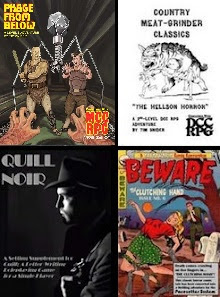Over the weekend, I discovered some old notes of mine from my days as a
live-action role-player. Yes, I was one of those guys who wandered the state parks, whacking on "orcs" and "goblins" with foam-core swords. Say what you want, but I had loads of fun back in those days. One of my favorite PCs to play was a cleric by the name of Jarrod Theodyne. Jarrod was a fledgling acolyte from The Temple of Divine Sight, which sorta leads me to today's post. I didn't want to play "yet another cleric" who was always spouting good-vs-evil, keep-the-faith rhetoric. So I came up with a fairly convoluted new religion -- one that was vague enough so I could make up details on the fly, but also one that would give me something more to do on the field other than spout prayers, lay on hands, and crush things with a mace. So here you go -- feel free to use this religious order in your own RPGs:

The Temple of Divine Sight is a faith that worships human knowledge, education, and wisdom above all else. As the faithful believe, only by expanding our knowledge of the world around us can we hope to achieve the very wisdom of the gods. Since human memory is fleeting and fallible, the Faithful spend their days recording everything they've seen, heard, and experienced. (All Temple clerics are talented scribes, able to read and write in several languages.) The written word is as close to a permanent record of the human condition that exists, therefore everything must be dutifully transcribed -- conversations, observations, thoughts, conclusions, questions, everything the cleric experiences is jotted down in an ever-present journal, known to the clerics as their "Tome".
To accumulate knowledge and wisdom for the church, Divine Sight clerics are sent out on a 1,000-day journey to experience the outside world. These clerics roam the countryside, speaking with the citizens, learning what they can, and recording everything down in their Tome. Oftentimes, these clerics meet up and join with adventurers, thinking that these stalwart individuals will provide them with new and unusual situations and knowledge to record and share with the church.

Clerics of The Temple also collect as much written material as they can gather. Scraps of scrolls, pages ripped from books, nothing is too minuscule or minor to be considered for the church's archives. Speaking of the archives, the primary Temple -- location unknown to all but the Faithful -- is said to be one of the largest libraries of non-magical books and tomes in the world. It is said that everything there is to know can be found somewhere in the church's massive libraries which fill up many large dorm-like buildings.
It goes without saying that the written word is their holy symbol, and their Tome is used for such rituals. When casting spells or turning the undead, the cleric's book glows with a holy light as the acolyte's wisdom is channeled through the book. Because of the sheer importance of the Tome both as a holy symbol as well as the symbolic storage of the cleric's knowledge with, the Tome is irreplaceable. Some clerics who have had their Tome stolen or lost have entered into lengthy quests to retrieve it.
You may be asking yourself about the nature of the "god" that the Temple denizens worship. Well, that's the part I've left deliberately vague when I played Jarrod. There are several ways you can play this depending on the nature of your personal campaign world:
** The Temple of Divine Sight doesn't worship any one "god" in the pantheon. Wisdom and knowledge are more important to the Faithful than the whims of some omnipotent being. And who's to say which omnipotent being is the most knowledgeable? Since they derive their arcane powers from expanding their own consciousness and knowledge of the world they live in rather than in esoteric philosophies, the Temple of Divine Sight could be played as "agnostic clerics," if such a theme appeals to you.
** If you wish to have a god, here's the way I played it. Only those clerics who have contributed the most to their Temple's collected works are entitled to know their god's True Name. Until they have risen in the ranks of the church and have earned the right to learn His Name, they must remain ignorant of this One True Fact. It is the symbolic withholding of His Name to those who are still learning that shows the cleric that they will never know everything -- only He knows all. Acolytes refer to their god as He Who Knows. And their prayers often start with the mantra "By His Unknown Name..." It could be a quest for your player to rise up the ranks to one day be entrusted with this most holiest of holy words -- the Real Name of his god!























































































